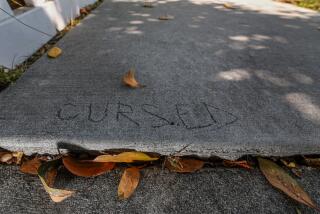Major cleanup of L.A. skid row, prompted by health report, begins
- Share via
The Los Angeles Department of Public Works, backed by police and firefighters, on Tuesday launched a major cleanup effort on downtown’s skid row to address urine, feces, discarded needles and other health dangers cited in a recent county report.
The operation, requested by Mayor Antonio Villaraigosa, is expected to last up to three weeks and is focused on the area between 5th and 7th streets and Gladys Avenue and Wall Street.
Notices were posted Monday on neighborhood walls, and officials with the Los Angeles Homeless Services Authority canvassed the area for weeks to ask people who sleep on the sidewalks to move their belongings during the cleanup, said Michelle Vargas, a spokeswoman for the Department of Public Works.
When city crews arrived on Gladys Avenue at 8:30 a.m. Tuesday, just a handful of people remained. They were given 20 minutes to move their bags and shopping carts before the area was cordoned off and sanitation workers in protective suits and gloves began moving through.
A woman in a wheelchair scrambled to drag a plastic crate filled with blankets and clothes out of the way.
“Why not do it every week?” said the woman, who spoke on condition that she be identified only by her first name, Patricia. “They do it up top every week … on Main, Los Angeles and Broadway. There’s a big difference between their streets and our streets.”
City officials say they were hampered by a federal court injunction issued last year that placed limits on the removal of unattended items. But they say the dangers cited in the public health report required action. The county Department of Public Health inspected a nine-block area and discovered human waste, hypodermic needles, condoms and a rat infestation in violation of state and county health codes.
Neighborhood activists, who have long clashed with the city over tactics used to clean up skid row, say the court order does not prevent city employees from removing items that present a health or safety risk. They accuse the city of deliberately allowing conditions to deteriorate to bolster its case against the injunction — a charge rejected by city officials.
“We are actually quite pleased that streets are being cleaned, but we remain concerned about personal property being taken and destroyed in the process,” said Pete White, co-director of the Los Angeles Community Action Network, which advocates for the poor.
He complained that police would not allow members of his group to get close enough to monitor the street cleaning effectively. Officials at the scene said it was dangerous to be on the sidewalk when crews moved through with pressure cleaners, disinfectant and rodent spray.
Dan Tucker, who has been homeless for three years, said he was “petrified” when he saw Tuesday’s cleaning operation. Last year, he left his belongings with a friend while he attended a mental health session. He returned to find city cleaning crews loading everything into a truck, he said.
“We had two tents, cookware, a gas stove, a radio,” he said over lunch at a soup kitchen at 6th Street and Gladys Avenue operated by the Los Angeles Catholic Worker. “It’s stuff we can’t replace because we don’t have the money.”
Vargas said city officials were trying to be sensitive. When sanitation workers discovered medicine and a wrist watch among a pile of clothing Tuesday, they placed the items in a plastic bag and sent them to a warehouse at 432 E. Temple Street, where they will be stored for 90 days. They then taped a notice to the wall explaining how the items can be claimed.
Free temporary storage is also available at the Central City East Check-In Center, a facility operated by one of the neighborhood business improvement districts, Vargas said. The city paid for an additional 500 storage bins, nearly doubling capacity.
But she said most of the items left behind Tuesday were contaminated with human waste and would be destroyed. City workers shoveled them into a truck and drove them away. They also removed dozens of needles, she said.
Times photographer Mark Boster contributed to this report.
More to Read
Sign up for Essential California
The most important California stories and recommendations in your inbox every morning.
You may occasionally receive promotional content from the Los Angeles Times.










